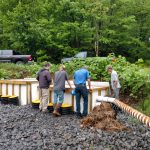#23: KL1 Klondike, low pH Iron Oxidation
Hi All,
We’ve been exceedingly fortunate to get Dr Art Rose on board to do an Iron study with us using a Mk318 (1800 gallon MRU) at KL1 Klondike, a acid mine drainage treatment site near Ashville PA.
Art, professor emeritus from PSU, Geology and Mineral Resources, has been working with the Clearfield Creek Watershed Association for a long time. When I asked around about good sites with very acidic water and high loads of dissolved iron (Fe2), Art pointed me at KL1, which is also close to my home in Altoona. After getting AMD Industries and Bill Gongaware out to take a look at the site for the 1-2 days of earth moving and construction, we developed a plan to replicate my previous studies with the Altoona Water Authority on low pH iron removal. Add to that the huge buzz over rare earth element mining from acid mine drainage waters and boy did we line up a neat study.
So in April we finally got all of the pieces together (MRU, machine, a few sets of hands, organic matrix for in the MRU, pipe…) and got the system installed.
Nothing ever goes exactly to plan, and we didn’t get the MRU as far down as we wanted, so head pressure has been an issue as the first cell removed iron and backs up to its overflows, but thats life. The important thing is that we’ve got data coming back that supports, and i feel will exceed, our first studies in 2015-16. Since my only job now is to stir and drain the MRU every few weeks to keep it working, Art has been doing all of the on site sampling and then taking it to a certified lab for quantification.
That means double blind data, the best you can get. The first study I did almost everything except for the lab analysis which was handled by Fairway Labs in Altoona.
Around July, Dr Peter Heaney and Athen Chen from PSU stopped down to look at the work being done and take some samples of the material precipitating in the MRU and at other points in the system. After running the samples at the MCL (material characterization lab, PSU, a beautiful building at main campus), Athena determined that the material was schwertmannite, a very common iron mineral produced by microbes in low pH water and the exact same stuff I found in my studies from 2015-16 at Squatter Falls.
Got to love consistency in research, makes the publications easier.
Art asked me to hold off for awhile on releasing any data till we get a few more months in (sampling bi-monthly). I can tell you that with the planned upgrades to pipes I expect that the larger Mk318 will show better treatment rates than the combined (2) Mk307’s from the earlier studies. This was the primary hypothesis Im testing, that a larger tank will be as efficient, or more so, at overall load removal, than the smaller tanks. I really had no idea to begin with, so the data we are getting back is a double surprise.
We’ll be doing a webinar on the 2015-16 results as a lead up to our latest results at KL1 and will get that posted to slideshare and youtube once we’ve put some spit and polish on it. We plan on doing another one in the summer once we’ve gathered a full year (and a winter’s worth) of data, dates to be announced.





